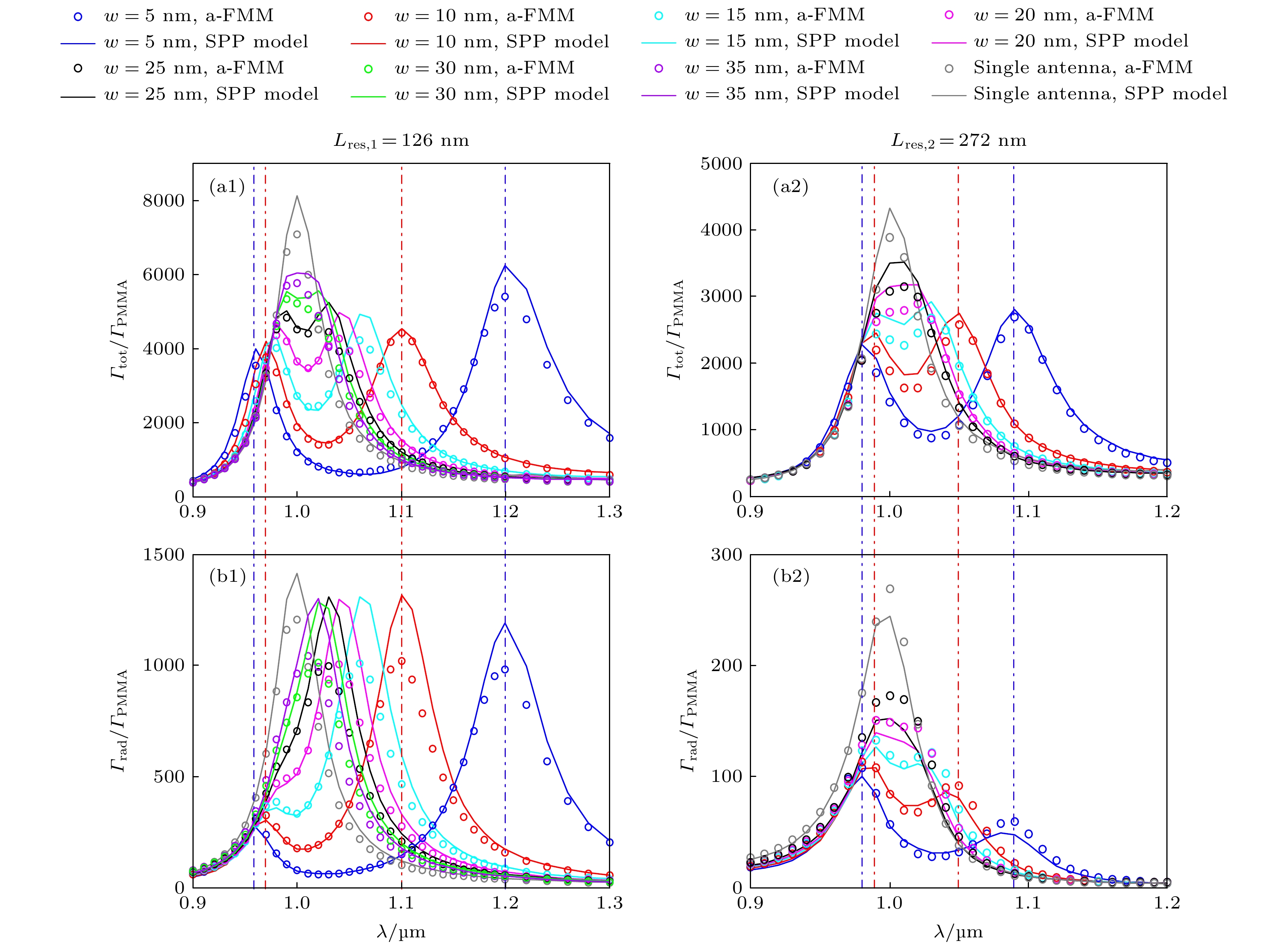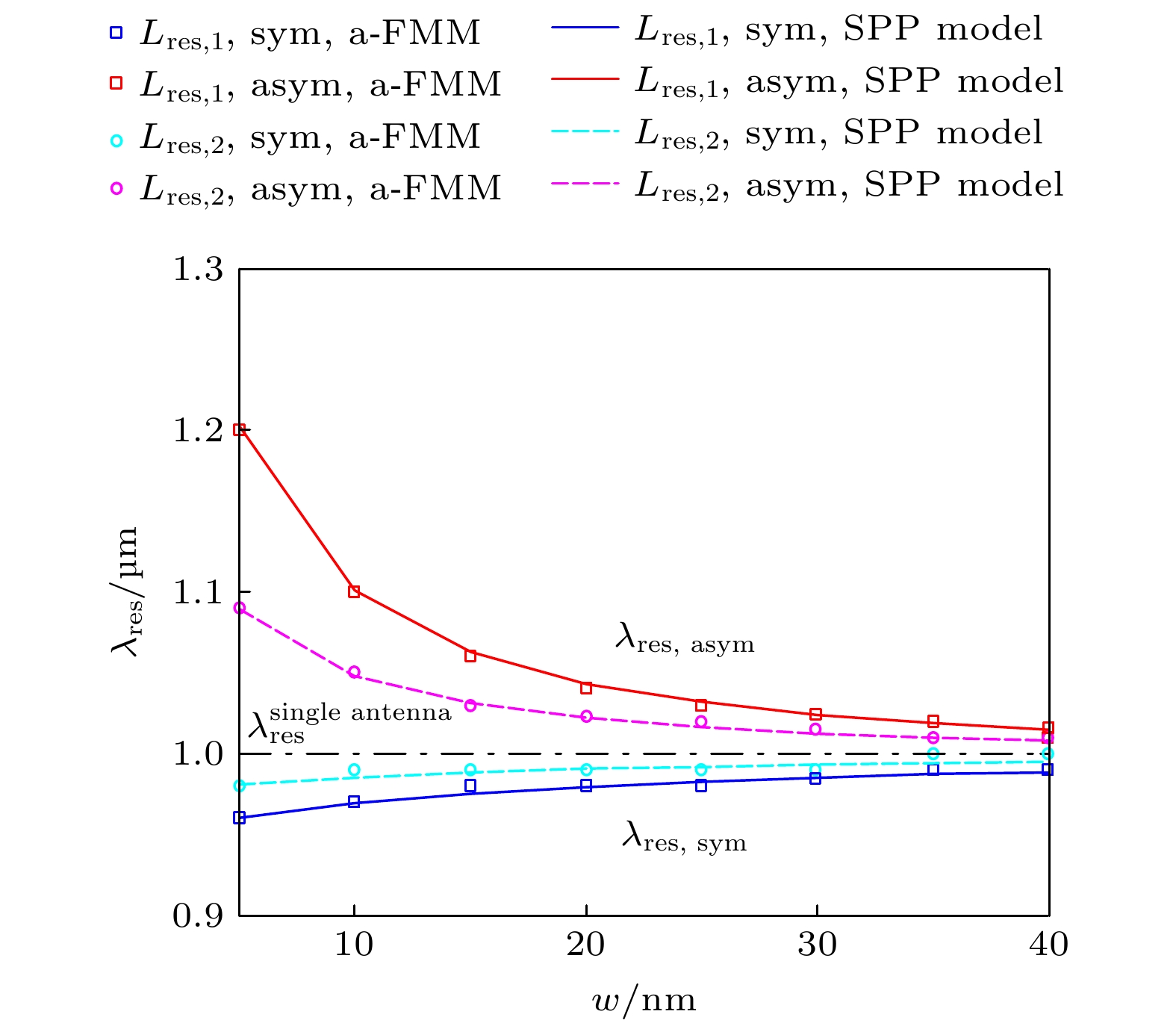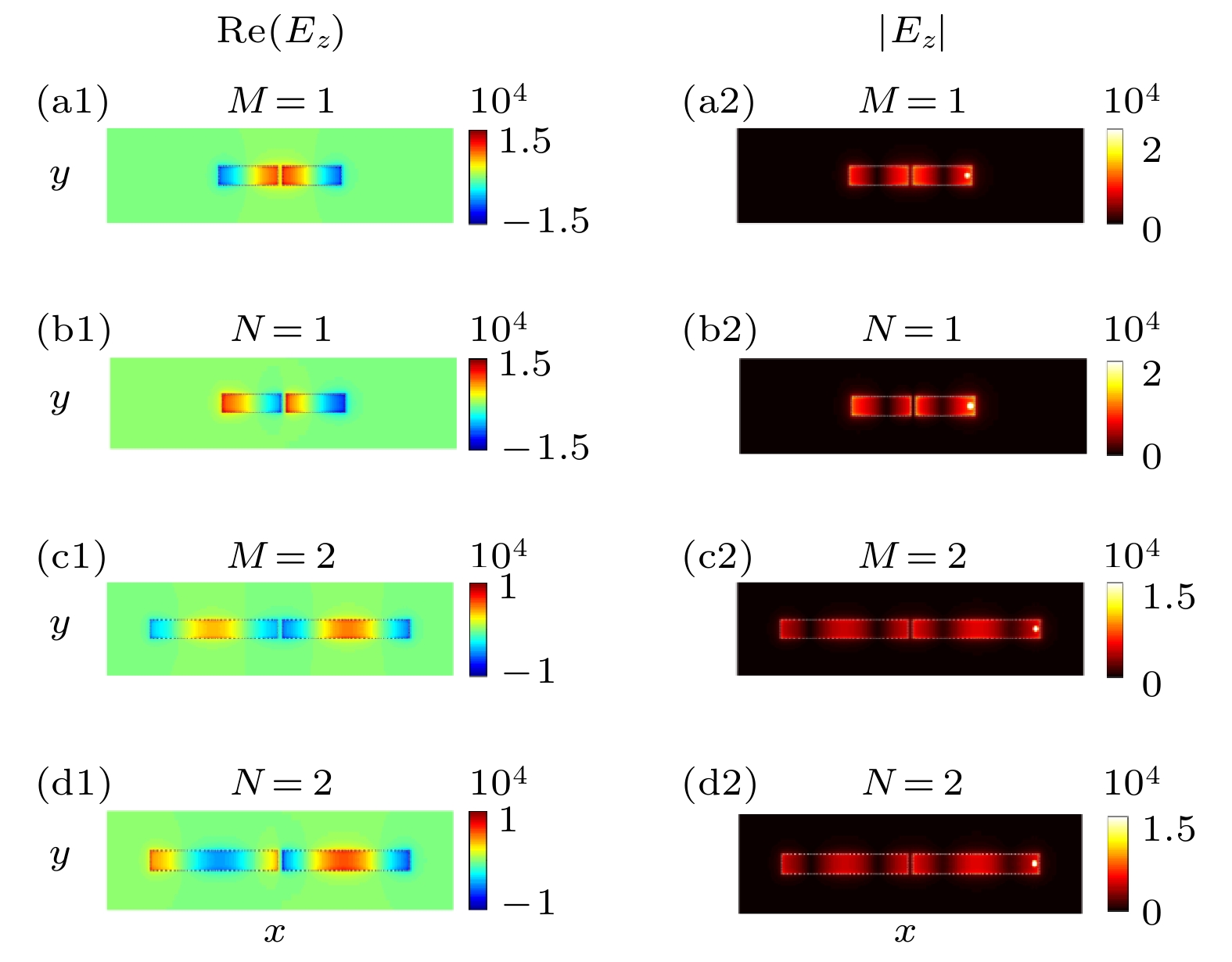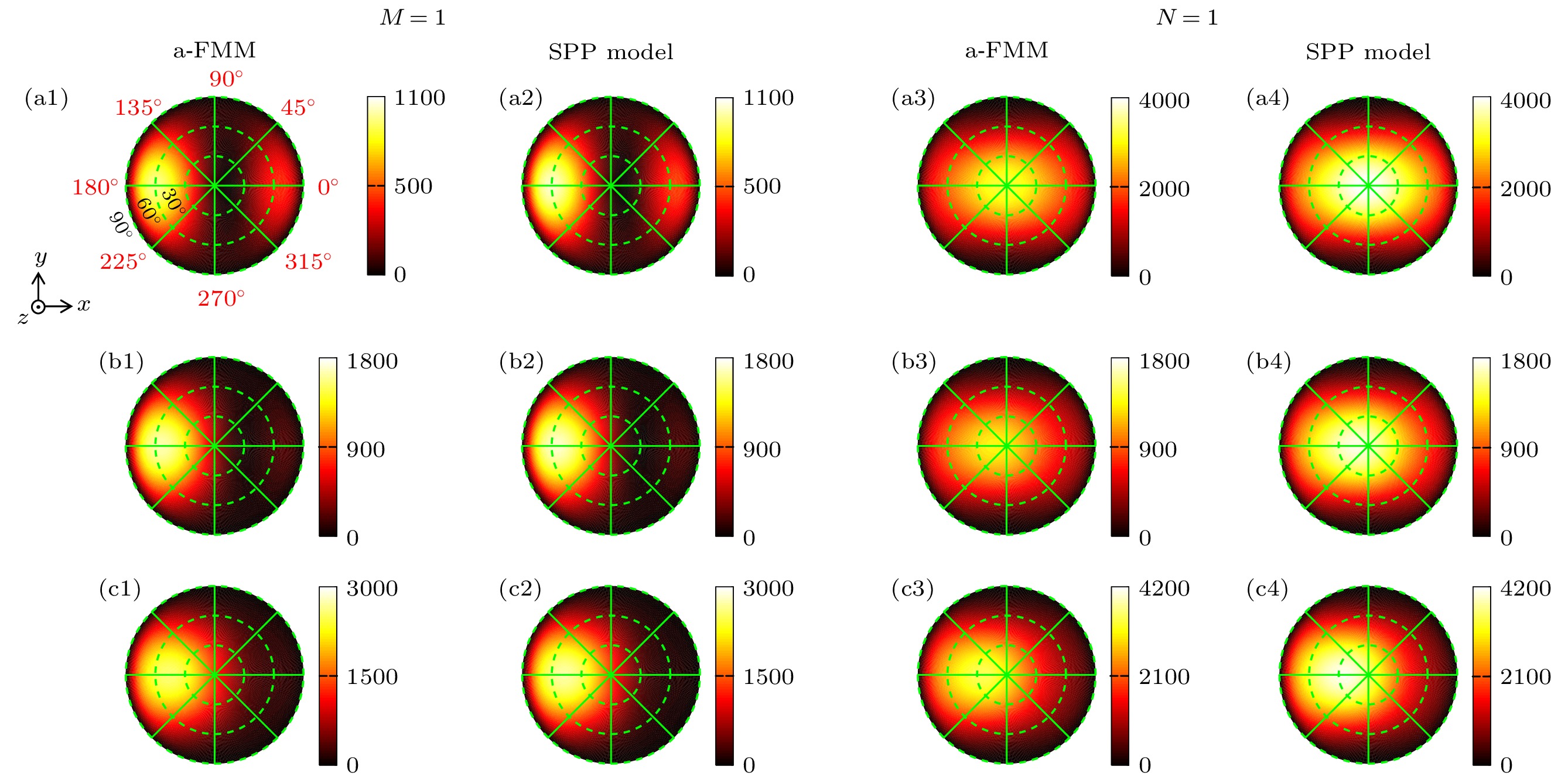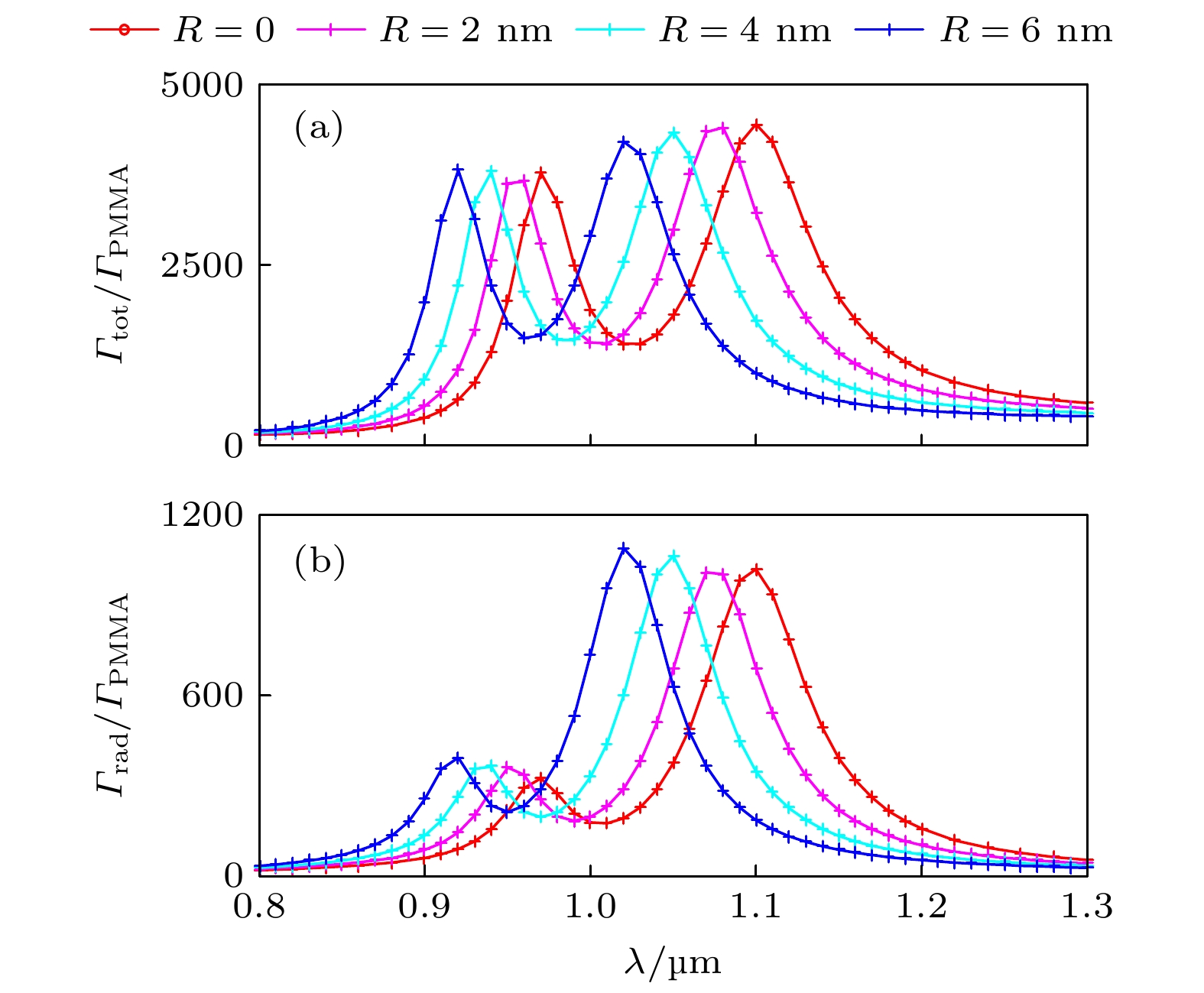-
本文提出一种具有宽波段自发辐射增强性能的金属基底上光学偶极纳米天线, 实现的总辐射速率与远场辐射速率增强因子分别达到5454和1041, 在近红外波段, 自发辐射增强(Purcell因子超过1000)波长范围达到260 nm, 并且能够实现远场定向辐射. 为了阐明天线性能背后的物理机制, 本文考虑天线臂上表面等离激元激发和多重散射的直观物理过程, 基于Maxwell方程组第一性原理, 建立了一个半解析模型, 能够全面复现天线的辐射特性, 包括总辐射速率、远场辐射速率、远场辐射方向图等. 该模型提供了一个直观的物理图像, 即在模型导出的两个相位匹配条件下, 表面等离激元在天线臂上形成了一对Fabry-Perot共振获得增强, 然后传播到纳米间隙内点辐射源位置和散射到自由空间, 由此分别提高了总辐射速率和远场辐射速率. 并且, 这一对Fabry-Perot共振产生了一对相互靠近的谐振峰, 由此形成了宽波段自发辐射增强. 本文提出的偶极纳米天线可以应用于荧光增强、拉曼散射增强及高速、高亮度纳米光源等领域, 所提出的模型可用于光学天线的物理理解和直观设计.
Optical nanoantennas can achieve electromagnetic-field enhancement under far-field excitation or spontaneous-emission enhancement under excitation by radiating emitters. Among them, nanoantennas on a metallic substrate (i.e. the so-called nanoparticle-on-mirror antennas) have aroused great research interest due to their ease in forming metallic gaps of sizes down to a few nanometers or even subnanometer. Here we propose an optical dipole nanoantenna on a metallic substrate with a broadband enhancement of spontaneous emission. Its total and radiative emission-rate enhancement factors can reach up to 5454 and 1041, respectively. In the near-infrared band, the wavelength range of spontaneous-emission enhancement (Purcell factor over 1000) can reach 260nm. By changing the width of the slit between the two antenna arms and also the length of the antenna arms, the spontaneous-emission enhancement bandwidth and enhancement factors can be adjusted, respectively, which brings great freedom and simplicity to the design process. The antenna can achieve a strong far-field radiation within a central anglular zone (polar angle θ≤60°) corresponding to a certain numerical aperture of objective lens, and therefore can increase the intensity of the fluorescence collected by the objective lens. Based on the above performances, the antenna can provide a broadband enhancement of spontaneous emission for fluorescent molecules or quantum dots (whose fluorescence spectrum usually covers a certain wavelength range), which is of great significance for the applications such as in high-speed and super-bright nanoscale light sources and high-sensitivity fluorescent-molecule sensing. To clarify the underlying physical mechanisms, we build up a semi-analytical model by considering an intuitive excitation and multiple-scattering process of surface plasmon polaritons (SPPs) that propagate along the antenna arms. All the parameters used in the model (such as the SPP scattering coefficients) are obtained via rigorous calculations based on the first principle of Maxwell's equations without any fitting process, which ensures that the model has a solid electromagnetic foundation and can provide quantitative predictions. The SPP model can comprehensively reproduce all the radiation properties of the antenna, such as the total radiative emission rate and the far-field radiation pattern. Two phase-matching conditions are derived from the model for predicting the antenna resonance, and show that under these conditions, the SPPs on the antenna arms form a pair of Fabry-Perot resonance and therefore are enhanced, and the enhanced SPPs propagate to the emitter in the nanogap (or scattered into the free space), so as to enhance the total spontaneous emission rate (or the far-field radiative emission rate). Besides, this pair of Fabry-Perot resonance results in a pair of resonance peaks close to each other, then enhancing the spontaneous emission with a broadband. -
Keywords:
- optical nanoantenna /
- spontaneous-emission enhancement /
- surface plasmon polariton /
- semi-analytical model
[1] Mühlschlegel P, Eisler H J, Martin O J F, Hecht B, Pohl D W 2005 Science 308 1607
 Google Scholar
Google Scholar
[2] Novotny L, Van Hulst N 2011 Nat. Photonics 5 83
 Google Scholar
Google Scholar
[3] Pelton M 2015 Nat. Photonics 9 427
 Google Scholar
Google Scholar
[4] Şendur K, Baran E 2009 Appl. Phys. B 96 325
 Google Scholar
Google Scholar
[5] Sederberg S, Elezzabi A Y. 2011 Opt. Express 19 10456
 Google Scholar
Google Scholar
[6] El-Toukhy Y M, Hussein M, Hameed M F O, Obayya S S A 2018 Plasmonics 13 503
 Google Scholar
Google Scholar
[7] Aizpurua J, Bryant G W, Richter L J, García de Abajo F J, Kelley B K, Mallouk T 2005 Phys. Rev. B 71 235420
 Google Scholar
Google Scholar
[8] Yong Z D, Zhang S L, Dong Y J, He S L 2015 Prog. Electromagnet. Res. 153 123
 Google Scholar
Google Scholar
[9] Lu G W, Liu J, Zhang T Y, Shen H M, Perriat P, Martini M, Tillement O, Gu Y, He Y B, Wang Y W, Gong Q H 2013 Nanoscale 5 6545
 Google Scholar
Google Scholar
[10] Akselrod G M, Argyropoulos C, Hoang T B, Ciracì C, Fang C, Huang J N, Smith D R, Mikkelsen M H 2014 Nat. Photonics 8 835
 Google Scholar
Google Scholar
[11] Hoang T B, Akselrod G M, Argyropoulos C, Huang J, Smith D R, Mikkelsen M H 2015 Nat. Commun. 6 7788
 Google Scholar
Google Scholar
[12] Kinkhabwala A, Yu Z H, Fan S H, Avlasevich Y, Müllen K, Moerner W E 2009 Nat. Photonics 3 654
 Google Scholar
Google Scholar
[13] Muskens O L, Giannini V, Sánchez-Gil J A, Gómez Rivas J 2007 Nano Lett. 7 2871
 Google Scholar
Google Scholar
[14] Baibakov M, Patra S, Claude J-B, Moreau A, Lumeau J, Wenger J 2019 ACS Nano 13 8469
 Google Scholar
Google Scholar
[15] Barulin A, Claude J-B, Patra S, Bonod N, Wenger J 2019 Nano Lett. 19 7434
 Google Scholar
Google Scholar
[16] Rycenga M, Xia X H, Moran C H, Zhou F, Qin D, Li Z Y, Xia Y N 2011 Angew. Chem. Int. Ed. 50 5473
 Google Scholar
Google Scholar
[17] Nie S, Emory S R 1997 Science 275 1102
 Google Scholar
Google Scholar
[18] Lodahl P, Mahmoodian S, Stobbe S 2015 Rev. Mod. Phys. 87 347
 Google Scholar
Google Scholar
[19] Tsakmakidis K L, Boyd R W, Yablonovitch E, Zhang X 2016 Opt. Express 24 17916
 Google Scholar
Google Scholar
[20] Suh J Y, Kim C H, Zhou W, Huntington M D, Co D T, Wasielewski M R, Odom T W 2012 Nano Lett. 12 5769
 Google Scholar
Google Scholar
[21] Ma R-M, Oulton R F, Sorger V J, Zhang X 2013 Laser Photonics Rev. 7 1
 Google Scholar
Google Scholar
[22] Harutyunyan H, Volpe G, Quidant R, Novotny L 2012 Phys. Rev. Lett. 108 217403
 Google Scholar
Google Scholar
[23] Butet J, Martin O J F 2015 Plasmonics 10 203
 Google Scholar
Google Scholar
[24] Gong T X, Guan F, Wei Z J, Huang W, Zhang X S. 2021 Front. Phys-Lausanne 9 691027
 Google Scholar
Google Scholar
[25] Zhang W H, Huang L N, Santschi C, Martin O J F 2010 Nano Lett. 10 1006
 Google Scholar
Google Scholar
[26] Fischer H, Martin O J F 2008 Opt. Express 16 9144
 Google Scholar
Google Scholar
[27] Yong Z D, Gong C S, Dong Y J, Zhang S L, He S L 2017 RSC Adv. 7 2074
 Google Scholar
Google Scholar
[28] Trojak O J, Park S I, Song J D, Sapienza L 2017 Appl. Phys. Lett. 111 021109
 Google Scholar
Google Scholar
[29] Zarrabi F B, Naser-Moghadasi M, Heydari S, Maleki M, Arezomand A S 2016 Opt. Commun. 371 34
 Google Scholar
Google Scholar
[30] Lumdee C, Yun B F, Kik P G 2014 ACS Photonics 1 1224
 Google Scholar
Google Scholar
[31] Baumberg J J, Aizpurua J, Mikkelsen M H, Smith D R 2019 Nat. Mater. 18 668
 Google Scholar
Google Scholar
[32] Huang S X, Ming T, Lin Y X, Ling X, Ruan Q F, Palacios T, Wang J F, Kong J, Dresselhaus M, Kong J 2016 Small 12 5190
 Google Scholar
Google Scholar
[33] Huang Y, Ma L W, Hou M J, Li J H, Xie Z, Zhang Z J 2016 Sci. Rep. 6 30011
 Google Scholar
Google Scholar
[34] Armstrong R E, van Liempt J C, Zijlstra P 2019 J. Phys. Chem. C 123 25801
 Google Scholar
Google Scholar
[35] Huang Y, Ma L W, Li J H, Zhang Z J 2017 Nanotechnology 28 105203
 Google Scholar
Google Scholar
[36] Purcell E M 1946 Phys. Rev. 69 681
[37] Lakowicz J R, Fu Y 2009 Laser Photonics Rev. 3 221
 Google Scholar
Google Scholar
[38] Agio M 2012 Nanoscale 4 692
 Google Scholar
Google Scholar
[39] Li L, Hutter T, Steiner U, Mahajan S 2013 Analyst 138 4574
 Google Scholar
Google Scholar
[40] Yoon J K, Kim K, Shin K S 2009 J. Phys. Chem. C 113 1769
 Google Scholar
Google Scholar
[41] Alu A, Engheta N 2008 Phys. Rev. Lett. 101 043901
 Google Scholar
Google Scholar
[42] Eggleston M S, Messer K, Zhang L M, Yablonovitch E, Wu M C 2015 Proc. Natl. Acad. Sci. U. S. A. 112 1704
 Google Scholar
Google Scholar
[43] Fernandez-Garcia R, Rahmani M, Hong M, Maier S A, Sonnefraud Y 2013 Opt. Express 21 12552
 Google Scholar
Google Scholar
[44] Calderón J, Álvarez J, Martinez-Pastor J, Hill D 2015 Plasmonics 10 703
 Google Scholar
Google Scholar
[45] Cooper C T, Rodriguez M, Blair S, Shumaker-Parry J S 2014 J. Phys. Chem. C 118 1167
 Google Scholar
Google Scholar
[46] Jia H, Yang F, Zhong Y, Liu H 2016 Photonics Res. 4 293
 Google Scholar
Google Scholar
[47] Lalanne P, Yan W, Vynck K, Sauvan C, Hugonin J P 2018 Laser Photonics Rev. 12 1700113
 Google Scholar
Google Scholar
[48] Sauvan C, Hugonin J P, Maksymov I S, Lalanne P 2013 Phys. Rev. Lett. 110 237401
 Google Scholar
Google Scholar
[49] Ching E S C, Leung P T, Maassen van den Brink A, Tong S S, Young K 1998 Rev. Mod. Phys. 70 1545
 Google Scholar
Google Scholar
[50] Della Valle G, Søndergaard T, Bozhevolnyi S I 2008 Opt. Express 16 6867
 Google Scholar
Google Scholar
[51] Taminiau T H, Stefani F D, van Hulst N F 2011 Nano Lett. 11 1020
 Google Scholar
Google Scholar
[52] Cubukcu E, Capasso F 2009 Appl. Phys. Lett. 95 201101
 Google Scholar
Google Scholar
[53] Hasan S B, Filter R, Ahmed A, Vogelgesang R, Gordon R, Rockstuhl C, Lederer F 2011 Phys. Rev. B 84 195405
 Google Scholar
Google Scholar
[54] Kim D, Jeong K Y, Kim J, Ee H S, Kang J H, Park H G Seo M K 2017 Phys. Rev. Appl. 8 054024
 Google Scholar
Google Scholar
[55] Chandran A, Barnard E S, White J S, Brongersma M L 2012 Phys. Rev. B 85 085416
 Google Scholar
Google Scholar
[56] Filter R, Qi J, Rockstuhl C, Ledere F 2012 Phys. Rev. B 85 125429
 Google Scholar
Google Scholar
[57] Wan J, Zhu J, Zhong Y, Liu H 2018 J. Opt. Soc. Am. A: 35 880
 Google Scholar
Google Scholar
[58] Jia H, Liu H, Zhong Y 2015 Sci. Rep. 5 8456
 Google Scholar
Google Scholar
[59] Zhai X, Wang N, Zhong Y, Liu H 2020 IEEE J. Sel. Top. Quantum Electron. 27 4600815
 Google Scholar
Google Scholar
[60] Kotal S, Artioli A, Wang Y, Osterkryger A D, Finazzer M, Fons R, Claudon J, Bleuse J, Gérard J M, 2021 Appl. Phys. Lett. 118 194002
 Google Scholar
Google Scholar
[61] Yang J, Kong F M, Li K, Sheng S W 2015 Opt. Commun. 342 230
 Google Scholar
Google Scholar
[62] Vesseur E J R, de Abajo F J G, Polman A 2010 Phys. Rev. B 82 165419
 Google Scholar
Google Scholar
[63] Edwards A P, Adawi A M 2014 J. Appl. Phys. 115 053101
 Google Scholar
Google Scholar
[64] Palik E D 1991 Handbook of Optical Constants of Solids, Part Ⅱ (San Diego: Academic)
[65] Anger P, Bharadwaj P, Novotny L 2006 Phys. Rev. Lett. 96 113002
 Google Scholar
Google Scholar
[66] Liu H T 2010 DIF CODE for Modeling Light Diffraction in Nanostructures (Tianjin: Nankai University)
[67] Hugonin J P, Lalanne P 2005 J. Opt. Soc. Am. A: 22 1844
 Google Scholar
Google Scholar
[68] Vassallo C 1991 Optical Waveguide Concepts (Amsterdam: Elsevier)
[69] Chang D E, Sørensen A S, Hemmer P R, Lukin M D 2007 Phys. Rev. B 76 035420
 Google Scholar
Google Scholar
[70] Li L 1996 J. Opt. Soc. Am. A: 13 1024
 Google Scholar
Google Scholar
[71] Li L (edited by Popov E) 2014 Gratings: Theory and Numeric Applications (2nd Ed.) (Marseille: Institut Fresnel, Aix Marseille Université) pp573—574
[72] Liu H 2013 Opt. Express 21 24093
 Google Scholar
Google Scholar
[73] Ortega J M, Rheinboldt W C 1970 Iterative Solution of Nonlinear Equations in Several Variables (New York and London: Academic)
[74] Li Y, Liu H, Jia H, Bo F, Zhang G, Xu J 2014 J. Opt. Soc. Am. A: 31 2459
 Google Scholar
Google Scholar
[75] Yang J, Hugonin J P, Lalanne P 2016 ACS Photonics 3 395
 Google Scholar
Google Scholar
-
图 1 (a) 金基底上金偶极纳米天线结构示意图; (b1), (b2) 对称点源和反对称点源激励下, SPP模型中的SPP模式系数
$a_{\rm sym/asym}^{+/-} $ ,$b_{\rm sym/asym}^{+/-} $ ,$c_{\rm sym/asym}^{+/-} $ ,$d_{\rm sym/asym}^{+/-} $ 的定义; (c)—(e) SPP模型中用到的SPP散射系数ρ, τ, r, β以及电磁场${\boldsymbol{ \varPsi}} _{{{\rm{SPP, + }}}}^{{{\rm{gap{\text{-}}scattering}}}}$ ,${\boldsymbol{ \varPsi}} _{{{\rm{SPP, + }}}}^{{{\rm{end{\text{-}}scattering}}}} $ , Ψsource的定义Fig. 1. (a) Schematic diagram of the gold dipole nanoantenna on a gold substrate; (b1), (b2) definition of the SPP mode coefficients
$a_{\rm sym/asym}^{+/-} $ ,$b_{\rm sym/asym}^{+/-} $ ,$c_{\rm sym/asym}^{+/-} $ ,$d_{\rm sym/asym}^{+/-} $ in the SPP model under excitation by symmetric and anti-symmetric point sources; (c)−(e) definition of the SPP scattering coefficients ρ, τ, r, β and electromagnetic fields${\boldsymbol{ \varPsi}} _{{{\rm{SPP, + }}}}^{{{\rm{gap{\text{-}}scattering}}}} $ ,${\boldsymbol{ \varPsi}} _{{{\rm{SPP, + }}}}^{{{\rm{end{\text{-}}scattering}}}} $ , Ψsource used in the SPP model.图 2 在y-z横截面上SPP基模式电场分量的模值(|Ex|, |Ey|, |Ez|), 在(y, z) = (0, H/2)处满足归一化Ez = 1. 图中叠加的虚线显示了结构的边界
Fig. 2. Moduli of the electric-field components (|Ex|, |Ey|, |Ez|) on the y-z cross section for the fundamental SPP mode satisfying normalization Ez = 1 at (y, z) = (0, H/2). The superimposed dashed lines show the boundaries of the structure.
图 3 在单个点源激励下, 偶极纳米天线的归一化总辐射速率Γtot/ΓPMMA((a1), (a2))和归一化远场辐射速率Γrad/ΓPMMA((b1), (b2)), 显示为点源辐射波长λ的函数. 结果分别采用a-FMM严格计算(圆圈)和SPP模型(实线)得到. (a1), (b1)天线臂长L = Lres, 1 = 126 nm. (a2), (b2) L = Lres, 2 = 272 nm. 不同天线臂间狭缝宽度w对应不同颜色的曲线. 灰色曲线对应单臂纳米天线的结果. 竖直点划线显示了方程(10)预测的谐振波长
Fig. 3. Normalized total emission rate Γtot/ΓPMMA ((a1), (a2)) and normalized radiative emission rate Γrad/ΓPMMA ((b1), (b2)) of the dipole nanoantenna under a single point-source excitation plotted as functions of the excitation wavelength λ. The results are obtained with the rigorous a-FMM calculation (circles) and the SPP model (solid curves), respectively. (a1), (b1) Antenna arm length L = Lres, 1 = 126 nm. (a2), (b2) L = Lres, 2 = 272 nm. Different widths w of the slit between the antenna arms correspond to curves of different colors. The gray curves show the results of a single-arm nanoantenna. The vertical dash-dot lines show the resonant wavelengths predicted by Equation (10).
图 4 偶极纳米天线谐振波长λres随狭缝宽度w变化的曲线. 图中λres, sym = λres, 1, λres, asym = λres, 2, λres, 1, λres, 2为图3中γT或γR的谐振波长. 方形、圆圈为a-FMM严格计算结果. 实线、虚线为SPP模型方程(10)预测的结果. 红色、蓝色曲线对应天线臂长L = Lres, 1 = 126 nm [对应方程(10)中M = N = 1], 洋红、青蓝色曲线对应L = Lres, 2 = 272 nm(对应M = N = 2). 水平点划线为方程(A5)预测的单臂纳米天线的谐振波长
Fig. 4. Resonant wavelength λres of the dipole nanoantenna plotted as a function of the slit width w. There are λres, sym = λres, 1 and λres, asym = λres, 2, with λres, 1 and λres, 2 being the resonant wavelengths of γT or γR shown in Figure 3. The squares and circles show the results obtained with the rigorous a-FMM calculation. The solid and dashed curves show the predictions of the SPP model Equation (10). The red and blue curves correspond to the antenna arm length L = Lres, 1 = 126 nm (obtained for M = N = 1 in Equation (10)). The magenta and cyan curves correspond to L = Lres, 2 = 272 nm (obtained for M = N = 2). The horizontal dash-dot line shows the resonant wavelength of the single-arm nanoantenna predicted by Equation (A5).
图 5 单个点源激励下, 天线纳米间隙内(z = H下1 nm截面上)主要电场分量Ez的近场分布 (a1), (a2), (b1), (b2) 天线臂长L = Lres, 1 = 126 nm, λres, sym = 0.97 μm, λres, asym = 1.10 μm (分别对应方程(10)中M = 1和N = 1); (c1), (c2), (d1), (d2) L = Lres,2 = 272 nm, λres,sym = 0.99 μm, λres, asym = 1.05 μm (分别对应M = 2和N = 2); (a1)—(d1) 显示了Re(Ez); (a2)—(d2) 显示了|Ez|. Ez做了归一化(除以ΓPMMA)
Fig. 5. Near-field distribution of the main electric-field component Ez in the antenna nanogap (on the cross-section of 1 nm below z = H) under excitation by a single point source: (a1), (a2), (b1), (b2) For antenna arm length L = Lres,1 = 126 nm and wavelengths λres,sym = 0.97 μm, λres,asym = 1.10 μm (respectively corresponding to M = 1 and N = 1 in Equation (10)); (c1), (c2), (d1), (d2) for L = Lres,2 = 272 nm and λres, sym = 0.99 μm, λres, asym = 1.05 μm (respectively corresponding to M = 2 and N = 2); (a1)−(d1) show Re(Ez); (a2)−(d2) show |Ez|. Ez is normalized (divided by ΓPMMA).
图 6 在单个点源激励下, 偶极纳米天线的远场辐射角分布P(θ, ϕ). 计算选取图4中天线臂长L = Lres, 1 = 126 nm, 以及不同的天线臂间狭缝宽度w对应的谐振波长λres, sym(第1, 2列), λres, asym(第3, 4列) (a1)—(a4) w = 5 nm, λres, sym = 0.96 μm, λres, asym = 1.2 μm; (b1) —(b4) w = 15 nm, λres, sym = 0.98 μm, λres, asym = 1.06 μm; (c1)—(c4) w = 35 nm, λres, sym = 0.99 μm, λres, asym = 1.02 μm. 叠加的圆和径向线分别对应极角θ和方位角ϕ
Fig. 6. Angular distributions P(θ, ϕ) of the far-field emission for the dipole nanoantenna under excitation by a single point source. The calculations are for antenna arm length L = Lres, 1 = 126 nm and resonance wavelengths λres, sym (columns 1 and 2) and λres, asym (columns 3 and 4) corresponding to different widths w of the slit between the antenna arms (as shown in Fig. 4). (a1)−(a4) w = 5 nm, λres, sym = 0.96 μm, λres, asym = 1.2 μm; (b1)−(b4) w = 15 nm, λres, sym = 0.98 μm, λres, asym = 1.06 μm; (c1)−(c4) w = 35 nm, λres, sym = 0.99 μm, λres, asym = 1.02 μm. The superimposed circles and radial lines correspond to the polar angle θ and azimuth angle ϕ, respectively.
图 A1 (a) 金基底上单臂纳米天线示意图; (b) 在单个点源激励下, SPP模型中SPP模式系数a1, a2, b1, b2的定义; (c) 归一化总辐射速率Γtot/ΓPMMA(蓝色曲线)和归一化远场辐射速率Γrad/ΓPMMA(红色曲线)随天线臂长L变化的曲线(固定波长λ = 1 μm). 圆圈和实线分别为全波a-FMM, SPP模型的结果. 竖直绿色虚线显示了方程(A5)确定的发生谐振的L
Fig. A1. (a) Schematic diagram of a single-arm nanoantenna on a gold substrate; (b) definition of the SPP mode coefficients a1, a2, b1, b2 in the SPP model under a single point-source excitation; (c) normalized total emission rate Γtot/ΓPMMA (blue curves) and normalized radiative emssion rate Γrad/ΓPMMA (red curves) of the antenna plotted as functions of the antenna arm length L (for fixed wavelength λ = 1 μm). The circles and solid curves show the results of the full-wave a-FMM and SPP model, respectively. The vertical green dashed lines show the L at resonance determined by Equation (A5).
图 B2 对于不同圆角化半径R的偶极天线(对应不同颜色的曲线), 在单个点源激励下, 归一化总辐射速率Γtot/ΓPMMA (a)和归一化远场辐射速率Γrad/ΓPMMA (b)随波长λ变化的曲线. 计算采用a-FMM(红色曲线)和FEM(粉色、青色、蓝色曲线). 选取天线臂长L = Lres,1 = 126 nm, 臂间狭缝宽度w = 10 nm
Fig. B2. For the dipole antenna with different radii R of rounded edges and corners (corresponding to curves of different colors), the normalized total emission rate Γtot/ΓPMMA (a) and normalized radiative emission rate Γrad/ΓPMMA (b) under excitation by a single point source, which are plotted as functions of wavelength λ. The calculation is performed with the a-FMM (red curves) and the FEM (pink, cyan, and blue curves). The antenna arm length is L = Lres,1 = 126 nm, and the width of the slit between the antenna arms is w = 10 nm.
-
[1] Mühlschlegel P, Eisler H J, Martin O J F, Hecht B, Pohl D W 2005 Science 308 1607
 Google Scholar
Google Scholar
[2] Novotny L, Van Hulst N 2011 Nat. Photonics 5 83
 Google Scholar
Google Scholar
[3] Pelton M 2015 Nat. Photonics 9 427
 Google Scholar
Google Scholar
[4] Şendur K, Baran E 2009 Appl. Phys. B 96 325
 Google Scholar
Google Scholar
[5] Sederberg S, Elezzabi A Y. 2011 Opt. Express 19 10456
 Google Scholar
Google Scholar
[6] El-Toukhy Y M, Hussein M, Hameed M F O, Obayya S S A 2018 Plasmonics 13 503
 Google Scholar
Google Scholar
[7] Aizpurua J, Bryant G W, Richter L J, García de Abajo F J, Kelley B K, Mallouk T 2005 Phys. Rev. B 71 235420
 Google Scholar
Google Scholar
[8] Yong Z D, Zhang S L, Dong Y J, He S L 2015 Prog. Electromagnet. Res. 153 123
 Google Scholar
Google Scholar
[9] Lu G W, Liu J, Zhang T Y, Shen H M, Perriat P, Martini M, Tillement O, Gu Y, He Y B, Wang Y W, Gong Q H 2013 Nanoscale 5 6545
 Google Scholar
Google Scholar
[10] Akselrod G M, Argyropoulos C, Hoang T B, Ciracì C, Fang C, Huang J N, Smith D R, Mikkelsen M H 2014 Nat. Photonics 8 835
 Google Scholar
Google Scholar
[11] Hoang T B, Akselrod G M, Argyropoulos C, Huang J, Smith D R, Mikkelsen M H 2015 Nat. Commun. 6 7788
 Google Scholar
Google Scholar
[12] Kinkhabwala A, Yu Z H, Fan S H, Avlasevich Y, Müllen K, Moerner W E 2009 Nat. Photonics 3 654
 Google Scholar
Google Scholar
[13] Muskens O L, Giannini V, Sánchez-Gil J A, Gómez Rivas J 2007 Nano Lett. 7 2871
 Google Scholar
Google Scholar
[14] Baibakov M, Patra S, Claude J-B, Moreau A, Lumeau J, Wenger J 2019 ACS Nano 13 8469
 Google Scholar
Google Scholar
[15] Barulin A, Claude J-B, Patra S, Bonod N, Wenger J 2019 Nano Lett. 19 7434
 Google Scholar
Google Scholar
[16] Rycenga M, Xia X H, Moran C H, Zhou F, Qin D, Li Z Y, Xia Y N 2011 Angew. Chem. Int. Ed. 50 5473
 Google Scholar
Google Scholar
[17] Nie S, Emory S R 1997 Science 275 1102
 Google Scholar
Google Scholar
[18] Lodahl P, Mahmoodian S, Stobbe S 2015 Rev. Mod. Phys. 87 347
 Google Scholar
Google Scholar
[19] Tsakmakidis K L, Boyd R W, Yablonovitch E, Zhang X 2016 Opt. Express 24 17916
 Google Scholar
Google Scholar
[20] Suh J Y, Kim C H, Zhou W, Huntington M D, Co D T, Wasielewski M R, Odom T W 2012 Nano Lett. 12 5769
 Google Scholar
Google Scholar
[21] Ma R-M, Oulton R F, Sorger V J, Zhang X 2013 Laser Photonics Rev. 7 1
 Google Scholar
Google Scholar
[22] Harutyunyan H, Volpe G, Quidant R, Novotny L 2012 Phys. Rev. Lett. 108 217403
 Google Scholar
Google Scholar
[23] Butet J, Martin O J F 2015 Plasmonics 10 203
 Google Scholar
Google Scholar
[24] Gong T X, Guan F, Wei Z J, Huang W, Zhang X S. 2021 Front. Phys-Lausanne 9 691027
 Google Scholar
Google Scholar
[25] Zhang W H, Huang L N, Santschi C, Martin O J F 2010 Nano Lett. 10 1006
 Google Scholar
Google Scholar
[26] Fischer H, Martin O J F 2008 Opt. Express 16 9144
 Google Scholar
Google Scholar
[27] Yong Z D, Gong C S, Dong Y J, Zhang S L, He S L 2017 RSC Adv. 7 2074
 Google Scholar
Google Scholar
[28] Trojak O J, Park S I, Song J D, Sapienza L 2017 Appl. Phys. Lett. 111 021109
 Google Scholar
Google Scholar
[29] Zarrabi F B, Naser-Moghadasi M, Heydari S, Maleki M, Arezomand A S 2016 Opt. Commun. 371 34
 Google Scholar
Google Scholar
[30] Lumdee C, Yun B F, Kik P G 2014 ACS Photonics 1 1224
 Google Scholar
Google Scholar
[31] Baumberg J J, Aizpurua J, Mikkelsen M H, Smith D R 2019 Nat. Mater. 18 668
 Google Scholar
Google Scholar
[32] Huang S X, Ming T, Lin Y X, Ling X, Ruan Q F, Palacios T, Wang J F, Kong J, Dresselhaus M, Kong J 2016 Small 12 5190
 Google Scholar
Google Scholar
[33] Huang Y, Ma L W, Hou M J, Li J H, Xie Z, Zhang Z J 2016 Sci. Rep. 6 30011
 Google Scholar
Google Scholar
[34] Armstrong R E, van Liempt J C, Zijlstra P 2019 J. Phys. Chem. C 123 25801
 Google Scholar
Google Scholar
[35] Huang Y, Ma L W, Li J H, Zhang Z J 2017 Nanotechnology 28 105203
 Google Scholar
Google Scholar
[36] Purcell E M 1946 Phys. Rev. 69 681
[37] Lakowicz J R, Fu Y 2009 Laser Photonics Rev. 3 221
 Google Scholar
Google Scholar
[38] Agio M 2012 Nanoscale 4 692
 Google Scholar
Google Scholar
[39] Li L, Hutter T, Steiner U, Mahajan S 2013 Analyst 138 4574
 Google Scholar
Google Scholar
[40] Yoon J K, Kim K, Shin K S 2009 J. Phys. Chem. C 113 1769
 Google Scholar
Google Scholar
[41] Alu A, Engheta N 2008 Phys. Rev. Lett. 101 043901
 Google Scholar
Google Scholar
[42] Eggleston M S, Messer K, Zhang L M, Yablonovitch E, Wu M C 2015 Proc. Natl. Acad. Sci. U. S. A. 112 1704
 Google Scholar
Google Scholar
[43] Fernandez-Garcia R, Rahmani M, Hong M, Maier S A, Sonnefraud Y 2013 Opt. Express 21 12552
 Google Scholar
Google Scholar
[44] Calderón J, Álvarez J, Martinez-Pastor J, Hill D 2015 Plasmonics 10 703
 Google Scholar
Google Scholar
[45] Cooper C T, Rodriguez M, Blair S, Shumaker-Parry J S 2014 J. Phys. Chem. C 118 1167
 Google Scholar
Google Scholar
[46] Jia H, Yang F, Zhong Y, Liu H 2016 Photonics Res. 4 293
 Google Scholar
Google Scholar
[47] Lalanne P, Yan W, Vynck K, Sauvan C, Hugonin J P 2018 Laser Photonics Rev. 12 1700113
 Google Scholar
Google Scholar
[48] Sauvan C, Hugonin J P, Maksymov I S, Lalanne P 2013 Phys. Rev. Lett. 110 237401
 Google Scholar
Google Scholar
[49] Ching E S C, Leung P T, Maassen van den Brink A, Tong S S, Young K 1998 Rev. Mod. Phys. 70 1545
 Google Scholar
Google Scholar
[50] Della Valle G, Søndergaard T, Bozhevolnyi S I 2008 Opt. Express 16 6867
 Google Scholar
Google Scholar
[51] Taminiau T H, Stefani F D, van Hulst N F 2011 Nano Lett. 11 1020
 Google Scholar
Google Scholar
[52] Cubukcu E, Capasso F 2009 Appl. Phys. Lett. 95 201101
 Google Scholar
Google Scholar
[53] Hasan S B, Filter R, Ahmed A, Vogelgesang R, Gordon R, Rockstuhl C, Lederer F 2011 Phys. Rev. B 84 195405
 Google Scholar
Google Scholar
[54] Kim D, Jeong K Y, Kim J, Ee H S, Kang J H, Park H G Seo M K 2017 Phys. Rev. Appl. 8 054024
 Google Scholar
Google Scholar
[55] Chandran A, Barnard E S, White J S, Brongersma M L 2012 Phys. Rev. B 85 085416
 Google Scholar
Google Scholar
[56] Filter R, Qi J, Rockstuhl C, Ledere F 2012 Phys. Rev. B 85 125429
 Google Scholar
Google Scholar
[57] Wan J, Zhu J, Zhong Y, Liu H 2018 J. Opt. Soc. Am. A: 35 880
 Google Scholar
Google Scholar
[58] Jia H, Liu H, Zhong Y 2015 Sci. Rep. 5 8456
 Google Scholar
Google Scholar
[59] Zhai X, Wang N, Zhong Y, Liu H 2020 IEEE J. Sel. Top. Quantum Electron. 27 4600815
 Google Scholar
Google Scholar
[60] Kotal S, Artioli A, Wang Y, Osterkryger A D, Finazzer M, Fons R, Claudon J, Bleuse J, Gérard J M, 2021 Appl. Phys. Lett. 118 194002
 Google Scholar
Google Scholar
[61] Yang J, Kong F M, Li K, Sheng S W 2015 Opt. Commun. 342 230
 Google Scholar
Google Scholar
[62] Vesseur E J R, de Abajo F J G, Polman A 2010 Phys. Rev. B 82 165419
 Google Scholar
Google Scholar
[63] Edwards A P, Adawi A M 2014 J. Appl. Phys. 115 053101
 Google Scholar
Google Scholar
[64] Palik E D 1991 Handbook of Optical Constants of Solids, Part Ⅱ (San Diego: Academic)
[65] Anger P, Bharadwaj P, Novotny L 2006 Phys. Rev. Lett. 96 113002
 Google Scholar
Google Scholar
[66] Liu H T 2010 DIF CODE for Modeling Light Diffraction in Nanostructures (Tianjin: Nankai University)
[67] Hugonin J P, Lalanne P 2005 J. Opt. Soc. Am. A: 22 1844
 Google Scholar
Google Scholar
[68] Vassallo C 1991 Optical Waveguide Concepts (Amsterdam: Elsevier)
[69] Chang D E, Sørensen A S, Hemmer P R, Lukin M D 2007 Phys. Rev. B 76 035420
 Google Scholar
Google Scholar
[70] Li L 1996 J. Opt. Soc. Am. A: 13 1024
 Google Scholar
Google Scholar
[71] Li L (edited by Popov E) 2014 Gratings: Theory and Numeric Applications (2nd Ed.) (Marseille: Institut Fresnel, Aix Marseille Université) pp573—574
[72] Liu H 2013 Opt. Express 21 24093
 Google Scholar
Google Scholar
[73] Ortega J M, Rheinboldt W C 1970 Iterative Solution of Nonlinear Equations in Several Variables (New York and London: Academic)
[74] Li Y, Liu H, Jia H, Bo F, Zhang G, Xu J 2014 J. Opt. Soc. Am. A: 31 2459
 Google Scholar
Google Scholar
[75] Yang J, Hugonin J P, Lalanne P 2016 ACS Photonics 3 395
 Google Scholar
Google Scholar
计量
- 文章访问数: 7876
- PDF下载量: 148
- 被引次数: 0


























 下载:
下载:

